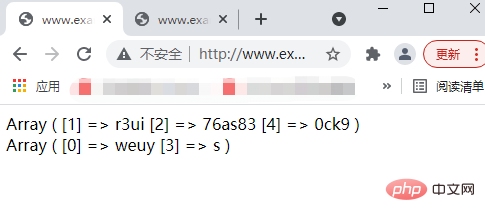How to locate elements in strings and arrays in PHP?
In the previous article "Take you to quickly master the replacement of PHP strings (detailed examples)" we introduced the relevant knowledge of character bed replacement in PHP in detail. Let's take a look at this article I hope this helps everyone with relevant knowledge about string positioning in PHP!

In the previous article, we learned that if you want to replace characters in a string in PHP, you need to use the substr_replace function provided by PHP With the str_replace function, this can solve the problem of PHP replacement. Similarly, string positioning is also very common in the PHP development process.
In PHP, if you want to search whether a string appears in another string, you can use the strstr function in PHP. Next, let’s take a look at how to locate and find a character. string.
<strong><span style="font-size: 20px;">strstr</span></strong>Function - Locate string element
In PHP, you can use the strstr function to search for the first occurrence of a string in another string. The basic syntax format of the strstr function is as follows:
strstr(string,search,before_search)
It should be noted that the parameter string represents the string to be searched, and the parameter search represents the string to be searched. If the parameter is not a string Then this parameter will be converted into an integer and used as the sequence number of the character. The default parameter before_search is false. If set to true, the returned result is the parameter search number. The part of the string before an occurrence.
The return result of this function is the remaining part of the string starting from the matching point. If the string to be searched is not found, the returned result is false.
Next let’s look at the use of strstr function through an example. The example is as follows:
<?php $email = '123456789123456789@gamil.com'; echo $email. '<br/>';//正常输出 $domain = strstr($email, '@');//通过strstr函数来搜索@出现的第一次位置 echo $domain; ?>
Output result:

In the above example, the result returned by the strstr function is the remaining part after the string we searched for. We accomplish the purpose of locating the string through the strstr function.
When it comes to positioning matching, we have to mention regular expressions in PHP. In the above, we completed the positioning string through the strstr function. There is another function in PHP which is preg_grep() function, let’s take a look at its usage.
<strong><span style="max-width:90%">preg_grep</span></strong>() function-locating array elements
When it comes to search positioning in PHP, the inevitable one is regular expressions. PHP provides preg_grep() to match array elements through regular expressions. The basic syntax format of
preg_grep() function is as follows:
array preg_grep ( string $pattern , array $input [, int $flags = 0 ] )
It should be noted that the parameter pattern is defined by a regular expression , that is, the pattern to be searched, the parameter input represents the array to be searched, and the parameter flags is generally set to PREG_GREP_INVERT represents the function at this time The returned result is an array of unmatched $pattern elements.
Next let’s look at the use of the preg_grep() function through an example. The example is as follows:
<?php
$pattern = '/[0-9]/';
$subject = array('weuy','r3ui','76as83','s','0ck9');
$arr = preg_grep($pattern,$subject);
show($arr);
function show($var){
if(empty($var)){
echo 'null';
}elseif(is_array($var)||is_object($var)){
echo '
';
print_r($var);
echo '
';
}else{
echo $var;
}
}
echo '<br/>';
$arr1 = preg_grep($pattern,$subject,PREG_GREP_INVERT);
show($arr1);
function show1($var1){
if(empty1($var1)){
echo 'null';
}elseif(is_array($var1)||is_object($var1)){
echo '
';
print_r($var1);
echo '
';
}else{
echo $var1;
}
}
?>Output result:

Through the above example, we can match the array elements, and the value of the parameter flags is different, and the results returned by the preg_grep() function are also different.
If you are interested, you can click on "PHP Video Tutorial" to learn more about PHP knowledge.
The above is the detailed content of How to locate elements in strings and arrays in PHP?. For more information, please follow other related articles on the PHP Chinese website!

Hot AI Tools

Undresser.AI Undress
AI-powered app for creating realistic nude photos

AI Clothes Remover
Online AI tool for removing clothes from photos.

Undress AI Tool
Undress images for free

Clothoff.io
AI clothes remover

Video Face Swap
Swap faces in any video effortlessly with our completely free AI face swap tool!

Hot Article

Hot Tools

Notepad++7.3.1
Easy-to-use and free code editor

SublimeText3 Chinese version
Chinese version, very easy to use

Zend Studio 13.0.1
Powerful PHP integrated development environment

Dreamweaver CS6
Visual web development tools

SublimeText3 Mac version
God-level code editing software (SublimeText3)

Hot Topics
 1664
1664
 14
14
 1422
1422
 52
52
 1316
1316
 25
25
 1267
1267
 29
29
 1240
1240
 24
24
 Explain JSON Web Tokens (JWT) and their use case in PHP APIs.
Apr 05, 2025 am 12:04 AM
Explain JSON Web Tokens (JWT) and their use case in PHP APIs.
Apr 05, 2025 am 12:04 AM
JWT is an open standard based on JSON, used to securely transmit information between parties, mainly for identity authentication and information exchange. 1. JWT consists of three parts: Header, Payload and Signature. 2. The working principle of JWT includes three steps: generating JWT, verifying JWT and parsing Payload. 3. When using JWT for authentication in PHP, JWT can be generated and verified, and user role and permission information can be included in advanced usage. 4. Common errors include signature verification failure, token expiration, and payload oversized. Debugging skills include using debugging tools and logging. 5. Performance optimization and best practices include using appropriate signature algorithms, setting validity periods reasonably,
 Explain late static binding in PHP (static::).
Apr 03, 2025 am 12:04 AM
Explain late static binding in PHP (static::).
Apr 03, 2025 am 12:04 AM
Static binding (static::) implements late static binding (LSB) in PHP, allowing calling classes to be referenced in static contexts rather than defining classes. 1) The parsing process is performed at runtime, 2) Look up the call class in the inheritance relationship, 3) It may bring performance overhead.
 PHP Program to Count Vowels in a String
Feb 07, 2025 pm 12:12 PM
PHP Program to Count Vowels in a String
Feb 07, 2025 pm 12:12 PM
A string is a sequence of characters, including letters, numbers, and symbols. This tutorial will learn how to calculate the number of vowels in a given string in PHP using different methods. The vowels in English are a, e, i, o, u, and they can be uppercase or lowercase. What is a vowel? Vowels are alphabetic characters that represent a specific pronunciation. There are five vowels in English, including uppercase and lowercase: a, e, i, o, u Example 1 Input: String = "Tutorialspoint" Output: 6 explain The vowels in the string "Tutorialspoint" are u, o, i, a, o, i. There are 6 yuan in total
 What are PHP magic methods (__construct, __destruct, __call, __get, __set, etc.) and provide use cases?
Apr 03, 2025 am 12:03 AM
What are PHP magic methods (__construct, __destruct, __call, __get, __set, etc.) and provide use cases?
Apr 03, 2025 am 12:03 AM
What are the magic methods of PHP? PHP's magic methods include: 1.\_\_construct, used to initialize objects; 2.\_\_destruct, used to clean up resources; 3.\_\_call, handle non-existent method calls; 4.\_\_get, implement dynamic attribute access; 5.\_\_set, implement dynamic attribute settings. These methods are automatically called in certain situations, improving code flexibility and efficiency.
 PHP and Python: Comparing Two Popular Programming Languages
Apr 14, 2025 am 12:13 AM
PHP and Python: Comparing Two Popular Programming Languages
Apr 14, 2025 am 12:13 AM
PHP and Python each have their own advantages, and choose according to project requirements. 1.PHP is suitable for web development, especially for rapid development and maintenance of websites. 2. Python is suitable for data science, machine learning and artificial intelligence, with concise syntax and suitable for beginners.
 PHP in Action: Real-World Examples and Applications
Apr 14, 2025 am 12:19 AM
PHP in Action: Real-World Examples and Applications
Apr 14, 2025 am 12:19 AM
PHP is widely used in e-commerce, content management systems and API development. 1) E-commerce: used for shopping cart function and payment processing. 2) Content management system: used for dynamic content generation and user management. 3) API development: used for RESTful API development and API security. Through performance optimization and best practices, the efficiency and maintainability of PHP applications are improved.
 PHP: A Key Language for Web Development
Apr 13, 2025 am 12:08 AM
PHP: A Key Language for Web Development
Apr 13, 2025 am 12:08 AM
PHP is a scripting language widely used on the server side, especially suitable for web development. 1.PHP can embed HTML, process HTTP requests and responses, and supports a variety of databases. 2.PHP is used to generate dynamic web content, process form data, access databases, etc., with strong community support and open source resources. 3. PHP is an interpreted language, and the execution process includes lexical analysis, grammatical analysis, compilation and execution. 4.PHP can be combined with MySQL for advanced applications such as user registration systems. 5. When debugging PHP, you can use functions such as error_reporting() and var_dump(). 6. Optimize PHP code to use caching mechanisms, optimize database queries and use built-in functions. 7
 The Enduring Relevance of PHP: Is It Still Alive?
Apr 14, 2025 am 12:12 AM
The Enduring Relevance of PHP: Is It Still Alive?
Apr 14, 2025 am 12:12 AM
PHP is still dynamic and still occupies an important position in the field of modern programming. 1) PHP's simplicity and powerful community support make it widely used in web development; 2) Its flexibility and stability make it outstanding in handling web forms, database operations and file processing; 3) PHP is constantly evolving and optimizing, suitable for beginners and experienced developers.




